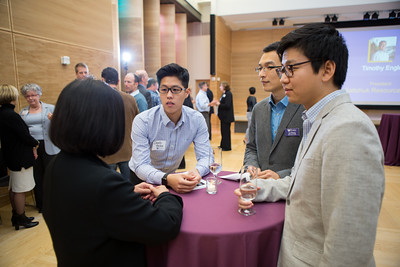International students find success amid growing evidence of diversity benefits for business
 Amid growing evidence of the business value of diversity, the University of Washington’s MBA program has a wealth of top international talent. In fact, a full one-third of the program’s full time graduates are international students. Over the past five years, 91 percent of these students found employment in the United States after graduation.
Amid growing evidence of the business value of diversity, the University of Washington’s MBA program has a wealth of top international talent. In fact, a full one-third of the program’s full time graduates are international students. Over the past five years, 91 percent of these students found employment in the United States after graduation.
Multiple studies show the value of these students in the US workplace. A 2015 study by global management consulting firm McKinsey & Company showed companies in the top quartile for racial and ethnic diversity are 35 percent more likely to receive above-median financial returns for their industry. Additional studies have shown that diverse boards tend to have better corporate governance practices and product development.
These back up research dating back to 1998, when researchers at a range of universities found that ethnic and gender diversity on corporate boards was associated with better stock performance.
Unpacking the benefits behind the studies
International students bring in global know-how, a fresh perspective and an intense loyalty to the company they join after graduation
 The value adds that international students from the University of Washington’s MBA program bring to the organizations they work for are substantial.
The value adds that international students from the University of Washington’s MBA program bring to the organizations they work for are substantial.
These students bring a global perspective that benefits both internationally-focused and US-focused ventures. They also bring a level of loyalty that comes with the experience of working hard for many years to attain US work authorization.
Take China-born Olivia Wang, who Microsoft hired in August after her graduation from the University of Washington’s MBA program that June. Wang has already used her international perspective to add value to Microsoft’s Central Marketing Organization, where she works as its marketing communications manager.
When the organization needed a good promotion to take to social media customers as part of its holiday campaign last year, Wang suggested giving virtual gifts – such as digital place card templates for dining tables – to customers. The fresh idea came naturally to her due to her international perspective.
“In the culture I grew up in, [giving gifts] is very deep in our hearts,” Wang said. “So I said ‘what if we give our customers a virtual gift every day?’”
The campaign saw high participation rates and all participants unwrapped their gifts, Wang said.
The global perspective of students such as Wang comes not only from growing up outside the US but also doing business there. Graduates of UW’s MBA program typically have six years of work experience before entering the program, meaning international students come in with considerable experience in their home countries, notes Sally Templeton, senior associate director for the UW Foster School of Business MBA Career Management team.
“They’re used to working in global environments and being able to communicate in different ways, depending upon their audience,” said Templeton, who advises students at Foster on the post-graduate career planning process.
This is particularly useful in places like Seattle, where a wealth of industries – from technology to seafood – have a large stake in international markets, said Templeton.
Also top among the benefits of hiring international students is that these students are intensely dependent upon – and thus loyal to – the companies they work for in order to retain authorization to live in the United States.
“Once you commit to hiring an international student, they are committed to you,” Templeton said. “They’re very committed, they’re very loyal, and they’re extremely hard workers.”
When interviewing at Microsoft, Wang says she knew the position would last at least five years due to the nature of her visa, and she says this is not uncommon among her international peers.
“Because of the extra commitments international students need to put in to work for a US-based company, they usually look for companies they are extra passionate about, and would love to work there for longer periods of time than local students,” Wang said.
Ready to make that international hire? It’s easier than you think
Here’s a guide to making legal international hires, from part-time student status options to full time permanent basis employees.
They’re used to working in global environments and being able to communicate in different ways, depending upon their audience
As Seattle’s need for international talent booms with the growth of tech and other industries, many employers already know they are interested in hiring foreigners. But what about the logistics of gaining legal authorization to take on non-US citizens? Is it really worth it? The answer may be yes much more often than employers think. In fact, there are programs for students and recent graduates that require minimal paperwork on the employer’s end.
Employers can legally take on foreign students for a year or two under F-1 status at financial cost and with no more paperwork than hiring a US citizen. They must simply attain I-9 verification, the same paperwork used to verify employment eligibility for US citizens. Students take care of the rest by applying for one of two types of Practical Training – Curricular Practical Training (CPT) or Optimal Practical Training (OPT) – from the university.
Job offers are students’ tickets to apply for CPT, which is authorized through UW International Student Services (ISS) in accordance with F-1 regulations. Students can complete CPT as employment, paid or unpaid internship experience, cooperative education experience or practicum participation. Under these options, they can work full time – any amount over 20 hours – or part time, with no added responsibility to the employer, since all credit fulfillment responsibilities lie with the student and their department. These options are explained in detail on the ISS website.
Those with at least one year of school under their belt can apply to OPT regardless of whether they have a job offer yet, but it is usually used by students who have already completed school as a way to extend employment beyond CPT.
Once the time allotment in these programs runs out, employers can use the H-1B visa program, which provides an initial term of three years and can be extended up to six years.
Because of the extra commitments international students need to put in to work for a US-based company, they usually look for companies they are extra passionate about, and would love to work there for longer periods of time than local students
H-1B visa program acceptance runs through a lottery system, which is completely random, and as a result uncertain. Last year, the U.S. Citizenship and Immigration Services (USCIS) says it received 233,000 applications total for the 85,000 visas available, leaving applicants with a 36 percent chance of receiving a visa that year. However, MBA students – and all graduate students – have a higher chance since they are allowed to enter the lottery twice. In other words, if graduate students do not receive a visa one year, they can re-apply.
The H-1B visa application requires employers to sponsor the employee. The minimum cost is $820 for non-profits and $1,820 for businesses, when including the $320 petition fee and anti-fraud fees. There is also an optional premium processing fee of $1,000, and some may find it useful to acquire legal consult, which adds legal fees to the cost.
In return, employers get a hire with deep knowledge of at least one overseas market and – perhaps more importantly – a new perspective to add to the ever-shifting business world.
Guest post by Jeanine Stewart
